
USDC
The USD Coin was developed by the Centre consortium founded by Circle, a peer-to-peer payments company based in Boston, Massachusetts.
Read our review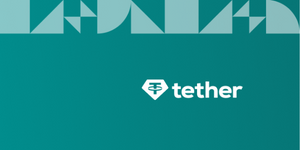
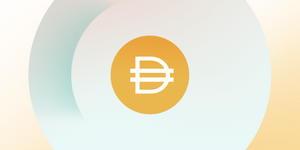
DAI
Dai is an Ethereum-based stablecoin managed by MakerDAO and developed by the Maker Foundation.
Read our review
TUSD
True USD is another dollar-backed stablecoin with collateral held in a 1:1 ratio.
Read our review
One of the major concerns that investors have over crypto is its volatility. With the wildly fluctuating prices of bitcoin and cryptocurrencies, it’s easy to understand.
Accordingly, several efforts have been made to create crypto that doesn’t behave this way – one that shows a bit more resiliency against volatility. The most successful is “stablecoins,” or a crypto asset backed by a particular coin or token with another asset (gold, fiat currency, etc.) to modulate price fluctuations and provide investors with an investment option that isn’t as risky as an untethered alternative.
In the 21st century, stablecoins are considered one of the significant financial breakthroughs of the era:
- Stablecoins are great for traders or investors who need to “hold value” in a digital asset without cryptocurrency’s volatile price swings.
- Stablecoins offer new ways of earning interest (a.k.a. “yield”) at a time when traditional savings vehicles provide next to nothing. (See our page on Best Interest Rates.)
- Stablecoins also offer a cheap, fast, and accessible means of transacting value across borders.
In this piece, we’ll cover our list of the best stablecoins and how savvy investors can use stablecoins to build wealth.
Top Stablecoins by Supply
To give you a visual of how the stablecoins stack up against each other, here’s a look at the top four that dominate supply. The supplies of USDT, USDC, TUSD, and DAI get distributed between multiple host blockchains.
What is Backing Each Stablecoin on the List?
Let’s look closer at the fundamentals and the teams behind each stablecoin on our shortlist:
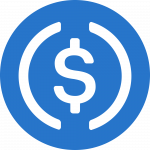 What Is USDC?
What Is USDC?
The USD Coin was developed by the Centre Consortium, founded by Circle, a peer-to-peer payments company based in Boston, Massachusetts. In August 2023, Circle and Coinbase closed the Centre Consortium, resulting in Circle gaining full governance of USDC.
Each USDC token has a corresponding $1 U.S, either as cash or cash equivalent invested in an owned account. Decentralization is ensured by allowing numerous projects to join a network of USDC issuers overseen by the Circle project, each of which maintains its cash reserves to stabilize the tokens it issues.
A new coin is created whenever someone buys or acquires USDC via currency conversion. When this happens, it is matched by an equal amount of US dollars deposited in independent currency reserves, either as cash or short-term US treasuries.
USDC is the backbone of Circle’s global payments service. The company has been valued at $9 billion as of 2023.
BMJ Score: 5.0
We gave USDC a score of 5.0 due to its high market cap and the solid team behind Circle. In August 2023, it was announced that USDC would launch six new blockchains between September and October, revving access and momentum behind the coin.
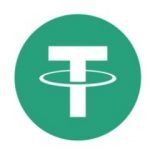 What Is USDT?
What Is USDT?
Tether holds the distinction of being one of the earliest stablecoins. Tether Limited, Inc. launched it in 2014 – 2015. Tether is owned by a Hong Kong-based company called iFinex Inc., which also owns Bitfinex, one of the largest crypto exchanges in the world.
On paper, Tether is pegged to the US Dollar in a 1:1 ratio, with cash and cash equivalent reserves fully collateralized. US authorities have questioned the validity of these claims, stating that the company sometimes does not hold enough cash/cash equal dollar reserves.
Recent filings indicate that Tether’s collateral includes a low percentage of cash reserves (around 7%), with the rest being cash equivalents, secured loans, corporate bonds, and other investments.
The link between Bitfinex and Tether was only revealed during the Paradise Papers financial data leak. Since then, there have been numerous controversies surrounding Tether’s ownership and management, with allegations of market manipulation and false advertising.
Due to controversies and a general lack of transparency, Tether has been losing ground to other stablecoins like the USDC. However, the token has maintained a stable 1:1 peg with the US dollar.
BMJ Score: 4.5
We gave Tether a score of 4.5 due to its recent upswing. In November 2023, Tether published a report stating that its reserves were healthy and even had $3.2B in surplus.
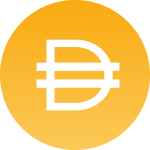 What Is DAI?
What Is DAI?
Dai is an Ethereum-based stablecoin managed by MakerDAO and developed by the Maker Foundation. The team was created by founder Rune Christensen in 2014 as a decentralized autonomous organization or DAO.
MakerDAO membership is limited to owners of the MKR – the project’s governance token. Members vote to decide the parameters and future roadmap of the DAI stablecoin.
Unlike other asset-backed stablecoins, Dai is not pegged to US dollars or gold. But it still aims to keep its value pegged at 1:1 to the US dollar through a system of Ethereum smart contracts. To create Dai tokens, users must purchase and stake an equal value (in U.S. Dollars) of Ethereum tokens.
Volatility in Ethereum severely affected Dai’s stability in 2020. As a result, MakerDAO has shifted much of its reserves to USD Coin, one of the most popular stablecoins in terms of market cap. Each Dai token is backed by 62% USDC and 29% ETH.
BMJ Score: 4.0
We gave Dai a score of 4.0 because it is currently the most popular algorithmic-backed stablecoin.
Additionally, its market cap jumped nearly $1 billion in August after it introduced reward rates as high as 8%.
 What Is TUSD?
What Is TUSD?
True USD is another dollar-backed stablecoin with collateral held in a 1:1 ratio. Launched in 2018, the crypto resides on TrustToken, a platform designed to create various asset-backed tokens. TUSD is one of the several cryptos launched by the TrustToken team.
The young team behind this project boasts some of the most impressive technology names in the field, albeit with limited financial experience. The company has its headquarters in San Francisco, California.
Actual USD reserves are held in an escrow account by third parties. Qualifying institutions can participate in the True USD system, eliminating the need for trust in a central project (albeit replacing that with trust in third-party accounting). With only two minor deviations, the price has remained stable within +/- $0.02.
BMJ Score: 4.0
We gave TrueUSD a BMJ score of 4.0 largely due to its trustworthiness. The company publishes regular attestations with strong legal protections provided by its escrow accounts.
 What Is USDP?
What Is USDP?
Pax Dollar, previously known as Paxos Standard or PAX, is a stablecoin launched by Paxos Trust Company. Based in New York, Paxos is a fintech company specializing in blockchain services, including cryptocurrency brokerage, asset tokenization, and asset settlement.
The team backing Paxos is a mixed bag with a wealth of expertise from tech and finance backgrounds. The stablecoin itself is asset-backed, with reserves of US Dollars held in a 1:1 ratio.
The stablecoin fully complies with the New York state financial service laws. Independent monthly audits validate the reserves. It is a relatively low-risk stablecoin, overshadowed by bigger alternatives like the USDC and Binance USD.
BMJ Score: 3.0
We gave USDP a score of 3.0 due to its high standards regarding consumer protection, as the stablecoin is subject to strict regulatory oversight by the New York State Department of Financial Services. Its reserves are held in cash and cash equivalents, meaning its customer funds are reportedly safe and available for redemption at any time.
 What Is GUSD?
What Is GUSD?
Gemini USD is a stablecoin launched by the Gemini Trust Company, a cryptocurrency exchange based in New York City. Tyler and Cameron Winklevoss, well-known Bitcoin billionaires and tech entrepreneurs founded Gemini.
With a total valuation of $7 billion and employing over 1000 people, Gemini is one of the largest regulated cryptocurrencies in the world.
GUSD is backed 1:1 by real dollars in reserve, with monthly audits conducted by reputed accounting firms. One of the first stablecoins to get regulatory approval in the US, Gemini USD is generally well-regarded for its transparency and reliability.
BMJ Score: 3.0
GUSD was among the first regulated stablecoins in the world. We gave it a score of 3.0 because it benefits from the direct supervision and regulatory oversight of the New York State Department of Financial Services. However, Gemini is currently dealing with some brand trust issues. This is because, as of November 2022, users with Gemini Earn accounts have had their investments frozen.
 What is Backing First Digital USD?
What is Backing First Digital USD?
Introduced in June 2023, First Digital USD will be backed by the US dollar or assets of an equivalent value held in reserves with First Digital Trust Limited, its appointed custodian. At its launch, FDUSD was issued on the BNB Chain and Ethereum blockchain, though it plans to join other blockchains.
Its trust company, First Digital Trust Limited, is mandated by Hong Kong law to keep all FDUSD reserves in their accounts, meaning there is no co-mingling with other assets.
Additionally, Hong Kong law requires that the reserves be held in cash and high liquidity assets, which First Digital claims to help ensure the 1:1 backing of the FDUSD.
BMJ Score: 3.0
We have FDUSD a score of 3.0 because it has taken off quite considerably since its launch. In August 2023, the coin’s market cap surged over 50%. The coin has also experienced rapid adoption, as Binance eliminated trading fees for FDUSD to other prominent coins.
Additionally, Binance has been encouraging consumers to convert their BUSD to FDUSD before it phases out BUSD in 2024. However, despite this rapid adoption and growth, FDUSD’s penetration in the broader crypto sector is still in its beginning stages.
 What Is FRAX?
What Is FRAX?
Frax (FRAX) is a different type of stablecoin. Unlike other stablecoins, which are either fully backed by collateral or backed by algorithms that try to keep the price stable, it has been designed as a hybrid of the two: a “fractional-algorithmic” stablecoin.
In December 2020, Sam Hamidi-Kazemian, an Iranian-American software programmer, introduced FRAX on the Ethereum mainnet. It derives its name from its hybrid fractional reserve system. Parts of its supplies are backed by collateral, while mathematical cryptographic algorithms back parts.
Hamidi-Kazemian created FRAX to provide highly scalable, decentralized money in the place of fixed-supply digital assets such as BTC. FRAX is pegged 1:1 to USD, meaning it strives to maintain 1 FRAX = $1.
BMJ Score: 2.5
We gave FRAX a score of 2.5 because, in 2022, it experienced a $25B stablecoin supply drop. However, the stablecoin is showing signs of rebounding, and in March 2023, the team behind FRAX voted to collateralize its stablecoin fully.
 What Is USDD?
What Is USDD?
Crypto entrepreneur Justin Sun, founder of Tron blockchain, created USDD, a US dollar-pegged algorithmic stablecoin. It was launched on BNB Chain, Ethereum, and TRON in May 2022.
USDD is “decentralized USD” and is managed through a TRON-based DAO. It maintains its 1:1 peg with USD by positioning itself as an over-collateralized stablecoin. It is backed not by a real-world asset but by a diversified basket of crypto assets such as TRX, BTC, and USDC.
USDD claims to be a decentralized, tamper-proof, and freeze-free stablecoin system. It eliminates the role of a centralized authority. In October 2022, the Commonwealth of Dominica accepted USDD as legal tender.
BMJ Score: 2.0
We gave USDD a score of 2.0 because the market cap on the coin is still very low. Additionally, the coin is only currently available on two exchanges, which do not accept US residents.
 What Is HUSD?
What Is HUSD?
Huobi is one of Asia’s largest cryptocurrency exchanges, founded in China and now operating out of Seychelles with offices in Singapore, Hong Kong, Japan, and the US. The HUSD is a stablecoin launched by Huobi through a startup called Stable Universal.
The firm issued the HUSD stablecoin token as a means to uncouple for pre-existing 3rd party stablecoins, as well as gain exposure in DeFi markets and platforms. Launched in 2018, HUSD replaced PAX, USDC, GUSD, and TUSD on the Huobi platform. It is pegged to the dollar in a 1:1 ratio.
Much like BUSD, Huobi’s stablecoin relies on Paxos as a custody partner. Every HUSD token is backed by U.S. dollars held by Paxos as cash reserves in money market accounts in the United States. Unlike other major stablecoins, HUSD does not rely on cash equWe gave HUSD a score of 1.5 because it’s currently grappling with a fair share of controversy and instability. In August 2023, it was ivalents.
BMJ Score: 1.5
reported that several of the company’s executives were arrested. As the company grappled with these arrests, its reserves dropped over 30%, and traders withdrew roughly $49 million in stablecoins.
 What Is BUSD?
What Is BUSD?
Developed by Binance, one of the largest cryptocurrency exchanges in the world, BUSD is a fully regulated stablecoin backed by U.S. dollars, issued via the Paxos Trust Company. Both Binance and Paxos have a wealth of industry-leading expertise.
Each BUSD is backed 1:1 by a reserve of dollars held by Paxos in a secure account. BUSD is fully backed by cash or cash equivalents reserves in the form of short-term US treasuries, much like the USD Coin. The entire system is fully compliant with the New York State financial regulations.
In September 2022, Binance announced that it would shut out other stablecoins on the exchange and convert those holdings into BUSD. The move could increase the market cap of BUSD and improve its already excellent price stability.
BMJ Score: 1.5
While BUSD used to be one of the top stablecoins, it is currently experiencing some volatility after the US Securities and Exchange Commission labeled it an “unregistered security.” Following this event, Binance announced in August 2023 that it would stop supporting BUSD in 2024. Additionally, Paxos announced that it would halt BUSD redemption by 2024.
What Is a Stablecoin?
Stablecoins explained: A stablecoin is a digital currency that retains its value because it’s backed by the value of an underlying asset, which can be anything from fiat currency to oil and gold or sometimes even cryptocurrency.
For example, Tether (USDT) and USD Coin (USDC) are stablecoins backed by US dollars held in reserve. Frax (FRAX), on the other hand, is the first stablecoin backed by asset collateralization and mathematical cryptographic algorithms.
Types of Stablecoins
Just as the government supports fiat currency, so are stablecoins supported by some other asset or authority. Here are the types of stablecoins and how they’re supported.
Fiat-Backed Stablecoins
Fiat-backed stablecoins are associated with a particular fiat currency: US dollars, Euros, etc. Fiat-backed stablecoins offer better stability, especially compared to crypto-backed stablecoins. While cryptocurrencies come with wild price fluctuations, fiat-backed stablecoins come with minimal price fluctuations, as there’s a trusted currency behind them.
Circle offers USDCoin, a fiat-backed stablecoin. This coin can be exchanged on a 1:1 ratio with the US dollar. It is generally safe, as every USDC is backed by one US dollar.
Crypto-Backed Stablecoins
As the name suggests, these are stablecoins “backed” by other crypto assets. Because cryptocurrency prices can be volatile, crypto-backed stablecoins are overcollateralized (meaning they keep extra crypto in reserves in case of a market crash).
For example, to borrow $5 of a crypto-backed stablecoin, you may need to “put in” (or lock up) $10 of another crypto asset as collateral. If the underlying crypto asset loses its value, you still have a built-in cushion of $5. In general, this volatility makes crypto-backed stablecoins less reliable than fiat-backed stablecoins.
The most popular crypto-backed stablecoin is Wrapped Bitcoin, backed by bitcoin and issued on the Ethereum blockchain.
Commodity-Backed Stablecoin
These stablecoins maintain value through precious metals or commodities such as real estate or oil. While these stablecoins are generally centralized, the centralization protects users from crypto volatility.
Commodity-backed stablecoins allow you to invest in assets that may otherwise be out of reach. For example, obtaining and storing a gold bar can be complex and expensive, so holding a “gold stablecoin” is an easier way to store value without buying the underlying commodity.
Gold is the most popular commodity to be collateralized. Paxos Gold, Tether Gold, and Digix are three of the most liquid gold-backed stablecoins.
Algorithmic Stablecoin
Algorithmic-backed stablecoins rely on specialized algorithms and smart contracts to manage the supply of circulating tokens. For example, suppose the price of an algorithmic stablecoin is set at $1, but the stablecoin price rises higher. In that case, the computer algorithm will automatically release more tokens into the supply to reduce the price.
Alternatively, an algorithmic stablecoin will reduce the number of tokens in circulation when the market price drops below the price of the fiat currency it tracks. Terra was a popular algorithmic stablecoin that lost its peg to the US Dollar in May 2022 when the crypto market crashed. The dramatic collapse of Terra exposed the inherent fragility of algorithmic stablecoins due to their dependence on market conditions, which can often become highly volatile.
The most popular algorithmic-backed stablecoin is Dai, which MakerDAO issues. Dai runs on the Ethereum blockchain and is pegged to the US dollar. Other popular algorithmic-backed stablecoins include FRAX, USDD, USDX, and SUSD.
Why Do We Need Stablecoins?

Here are some primary use cases:
- Safe Haven Asset: Unlike cryptocurrencies that fluctuate dramatically, those using stablecoins to store value have minimal risk of loss.
- Payments: Businesses can benefit from accepting stablecoins as payment, allowing them to reduce transaction fees that come with typical payment processors.
- Instant Settlements: When settlements are paid out, they often can’t be immediately delivered because they’re subject to regular banking hours. Stablecoins operate on blockchain, meaning they run 24/7: parties can receive settlement immediately.
- Lending: Stablecoin lending is a high-yield opportunity for crypto investors, as it can offer double-digit interest.
- Escrow: Stablecoins automate the process through smart contracts that evaluate escrow conditions without using institutional intermediation.
- Alternative Banking: 14.1 million American adults are unbanked. You only need internet access to have a stablecoin “account,” opening financial access to all.
How Do You Make Money with Stablecoins?
Most people make their money with regular cryptocurrency through trading, mining, staking, lending, or yield farming. Because stablecoins are tied to an asset, making money with stablecoin works differently. Here are the ways to make money with stablecoins:
- Staking: Staking involves helping maintain the flow of the blockchain network on a particular asset. In return, you earn compensation from income from the network. Essentially, you’re locking in your stablecoins to receive rewards. Examples of stablecoins that offer staking rewards include Binance, Tether, and PAX Gold. (See our guide to Best Crypto Staking Yields.)
- Lending: You can lend your stablecoins out to borrowers to earn money, with rates of return ranging from 5 to 12 percent. You can lend your stablecoin on many major crypto lending platforms, such as Celsius. (See our guide to Top Crypto Lending Platforms.)
- Yield Farming: Yield farming allows investors to earn money by lending stablecoins through smart contracts, like earning interest on a traditional savings account. (See our guide to Best Yield Farming Rates.)
How Price-Stable Are Stablecoins?
When looking at the prices of stablecoins on digital asset platforms, you will notice that stablecoins often do not remain “stable” at $1.00. For example, at the time of writing this article, the Gemini Dollar (GUSD), Tether (USDT), and First Digital USD (FDUSD) were trading at $1.01, $1.00044, and $0.999878, respectively. This movement away from the $1 peg is not unusual, and each stablecoin has mechanisms that quickly bring the price back to the desired peg.
The reason is that the issuers of dollar-collateralized stablecoins need to manage the supply of their coins through issuing and burning/redeeming to ensure the value of their coins stays roughly on par with the US dollar.
However, there have also been several stablecoins that have lost their peg entirely. Among fiat-backed stablecoins, Steem Dollars (SBD) is a notable example. Part of the Steemit network, SBD was designed to maintain its value at one dollar.
The startup behind the Steemit network eventually stopped managing the coin’s money supply and let the digital currency float freely. This caused the coin’s value to surge to $15 during the 2017 rally before crashing down as low as $0.51.
But the most catastrophic example of a stablecoin losing its peg has to be the story of Terra. An algorithmic stablecoin launched in 2018, Terra was a very popular project helmed by a capable team of experts and backed by major investors like HashKey Digital Asset Group and Huobi Capital.
Terra (UST) was tied to its governance token LUNA, and the system relied on a combination of investor demand, pricing data, and market volatility to maintain a 1:1 peg to the US dollar. The values of UST and LUNA were interlinked in this system.
Terra was also linked to a lending platform called Anchor, which promised 20% yields to anyone who staked UST on their platform. This created an influx of users to the Terra blockchain, and the price of LUNA reached an all-time peak of $120 as the demand for UST increased.
During the crypto market crash in May 2022, short selling by wealthy investment firms triggered panic selling by other investors as UST lost its peg to the dollar. This bank run created a “death spiral,” collapsing the value of both UST and LUNA in a matter of days.
The event wiped out nearly $60 billion from Terra investors, dealt a severe blow to the entire crypto market, and raised serious questions about the stability of stablecoins. Many experts cited this as a lesson about the glaring weaknesses in the concept of “algorithmic stablecoins.”
It must be noted that fiat and gold-backed stablecoins are far more resistant to such volatility. However, even these stablecoins are not 100 percent price-stable. Moreover, due to their centralized nature and occasional lack of transparency, even fully-collateralized stablecoins carry some risk.
Investor Takeaway
For a currency to work, it has to store value reliably. Savers need to feel confident that the amount of money they put in the bank on Monday will reasonably reflect their wealth on Friday. Both inflation and deflation need to stay under control.
That is why several digital currency projects have taken a new approach. Instead of replacing traditional money, they’ll work alongside it. “Stable cryptocurrencies” peg themselves to a fiat currency, typically the dollar, and automatically adjust the number of tokens in circulation to keep the price stable.
Always do your research and never invest more than you are willing to lose. And consider subscribing to Bitcoin Market Journal to help you become a smart crypto investor.

